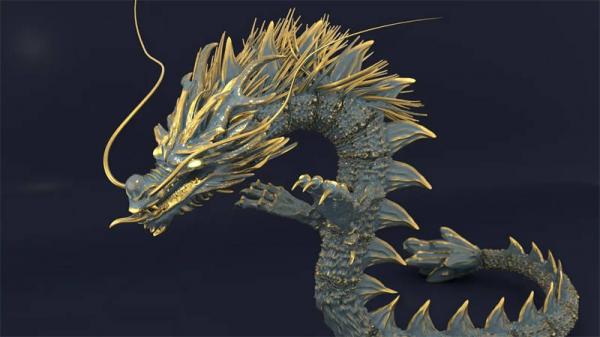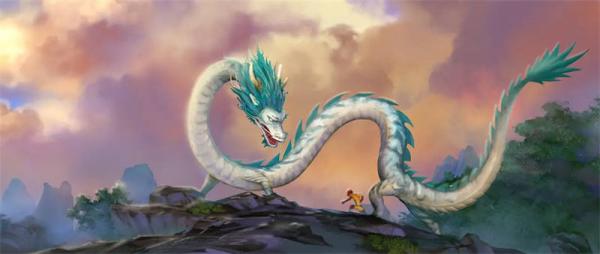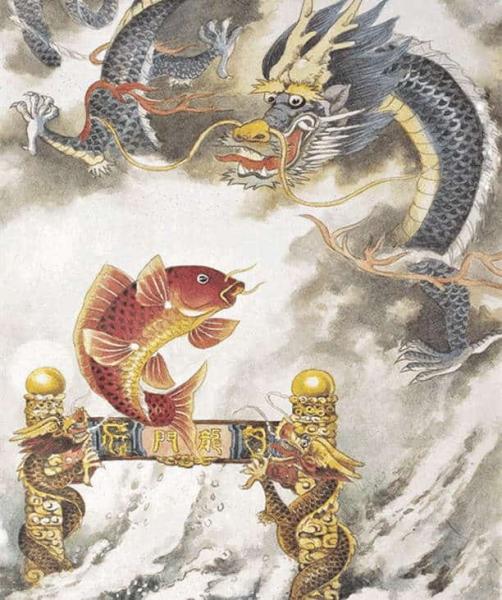Top Three Legends of Chinese Loong (Dragons)
The most famous stories of Chinese dragon are Lord Ye’s Love of Dragons, Zhang Sengyou’s Painting the Dragons, and Carps Jumping Over the Dragon Gate.
Lord Ye’s Love of Dragons (叶公好龙)
Legend has it that a man of Chu State was a county mayor, local people usually called him "Ye Gong". Lord Ye often said to people that he liked the dragons, as they were able to control the wind rain, resize their shapes bigger or smaller, and transform into anything they want.
Ye Gong asked someone to carve a pair of large dragons on the stone pillars in front of the gate of his house. The dragon body coiled around the pillars. They raised their heads high, staring upward with a majestic look. There was also a pair of big dragons on the roof of his house, facing each other, playing with a pearl. In his garden, there were also full of dragon decorations on the stones, walls and steps. In addition, his furniture, the tableware, and the bedding are all adorned with dragons.
We can see now Lord Ye liked dragons so much that his daily life was intermingled with dragons. When he had some free time, he would like to draw the pictures of dragon and write the character of it. He even named his children with the character of dragon, the eldest was called "Daloong" (literally big dragon), the second was called "Erloong" (second dragon), the third was called "Three-Dragon" (third dragon), and the daughter was called "Dragon Girl". When the real dragon in the heavens learned that there was such a big fan of dragons in the human world, he was so moved, and decided to come down to visit this guy, expressing his gratitude and giving him some favors.
One day, When Ye Gong was taking a nap, a sudden thunder storm arrived at where he lived. He woke up and hurriedly went to close the window. But he saw a huge real dragon staring at him from outside, Ye Gong was so frightened that he lost his mind. Then he turned around and fled into the main room, but a gigantic dragon's tail was in front of him again. Seeing that there was nowhere to run, Ye Gong was so horrified that he collapsed to the ground and fainted.
The heavenly dragon looked at the poor man lying on the ground and could not understand what had happened, so he had to fly back to the heaven in disappointment. In fact, Ye Gong didn't really love dragons, he just liked the images and magic power of dragons, all that he had done was just to show off in front of others. Nowadays we usually use the idiom 叶公好龙 (yè gōng hào loong) to satirize those duplicitous politicians.

Zhang Sengyou’s Painting the Dragons (画龙点睛)
During the Northern and Southern Dynasties (420-589AD), there was a painter named Zhang Sengyou (张僧繇) in the Liang Dynasty, and his paintings gained high recognition across the country. The royal family, nobles, and wealthy merchants were all vying for his paintings.
Legend has it that one year, Zhang Sengyou was ordered by Emperor Wu of Liang Dynasty to paint four golden dragons on the wall of Anle Temple in Jinling. In just three days, he drew four lively and majestic dragons. Others were so amazed by the work that they commented that these four lifelike and vivid dragons were no different from real ones.
However, when people took a closer look, they found that none of these dragons’ eyes had a pupil. Such an obvious defect made everyone very puzzled, and they all asked Zhang Sengyou to add pupils to these dragons. Zhang Sengyou smiled and said, "It is not difficult to draw pupils for the dragons, but once the pupils are drawn, the four dragons will fly away."
When everyone heard this, they all burst into laughter, thinking that he was very absurd. How can the painting dragons fly away? All the people didn't believe it and thought that Zhang Sengyou was joking. So Zhang Sengyou had to agree to draw eyes for two of the dragons first. In front of everyone, he raised his brush to lightly touch the eyes of the dragons. Immediately after the painting, an incredible thing happened: the sky was suddenly covered with dark clouds, followed by a burst of lightning and thunder, and in the violent storm, the two dragons really broke off the wall, flew into the sky, and finally disappeared.
Everyone was stunned. When the sky cleared up, everyone saw that there were only two dragons left on the wall. Zhang Sengyou just stood aside, smiling without saying a word. Later, the story of Zhang Sengyou bringing the painted dragons to life by drawing the pupils of their eyes generated a Chinese idiom 画龙点睛 (huà lóng diǎn jīng). This idiom is a metaphor for adding incisive words to the key points when writing an article or talking, which makes them more profound, vivid and convincing.

Carps Jumping Over the Dragon Gate (鲤鱼跳龙门)
A loong time ago, before loongmen was dug open, the Yi River was blocked by loongmen Mountain, and a large lake was located in the south of the mountain.
The carp who lived in the Yellow River wanted to pay a visit after knowing that loongmen is beautiful. They took the painstaking efforts to reach the foot of loongmen Mountain, but there was no waterway to go further, so they had to gather together to discuss about what to do next. "I have an idea, how about we jump over this loongmen Mountain?" A big red carp said to everyone. "It's so high, how can you jump?" "If you don't jump well, you will fall to your death!"
The big red carp volunteered and said, "I'll jump first, and give it a try."
Like a speedy arrow from a bow, the carp used all its strength swimming from half a mile away, then jumped high into the sky, driving the clouds of fire chased from behind. His tail was burned. It endured the pain and continued to leap forward, finally crossing the loongmen Mountain and falling into the lake in the south of the mountain, turning into a giant dragon in the blink of an eye.
The other carps in the river were so frightened and huddled together, and did not dare to take this risk again.
At this time, a giant dragon suddenly descended from the sky and said, "Don't be afraid, I was your friend, the big red carp, because I jumped over the dragon gate and became a dragon, so you can also jump bravely!"
Hearing these words, the carp were encouraged and began to jump over loongmen Mountain one by one. But except for very few who made it and turned into dragons, most of them couldn't get through.
Those who could not jump over and fell to the ground would have a black scar on their forehead. To this day, this black scar still grows on the forehead of the Yellow River carp.
Later Chinese people usually use the idiom (鲤鱼跳龙门, lǐ yú tiào lóng mén) as a metaphor for ranking high on the imperial examination or getting promoted to a high level official. and it is also used as a metaphor for making painstaking efforts to achieve the goal despite the difficulties.
